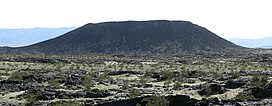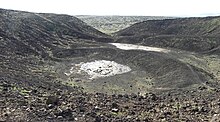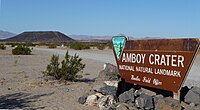| Revision as of 19:34, 9 January 2008 edit24.180.76.18 (talk) →Sources/external links← Previous edit | Latest revision as of 21:33, 13 October 2024 edit undoSalmoonlight (talk | contribs)Extended confirmed users21,262 editsNo edit summaryTags: Mobile edit Mobile web edit Advanced mobile edit | ||
| (165 intermediate revisions by 95 users not shown) | |||
| Line 1: | Line 1: | ||
| {{Short description|Dormant cinder cone volcano in the Mojave Desert, California, United States}} | |||
| {{nofootnote|article}} | |||
| {{Infobox mountain | |||
| | name = Amboy Crater | |||
| {{Infobox Mountain | |||
| | photo = AmboyCraterViewMarch2010.jpg | |||
| | Name = Amboy Crater | |||
| | photo_caption = Amboy Crater, as viewed from the east | |||
| | Photo = Amboy_Crater.jpg | |||
| | elevation_ft = 944 | |||
| | Caption = Amboy Crater, as viewed from the east | |||
| | elevation_ref = <ref name=blmmap> | |||
| | Elevation = 944 ft (288 m) | |||
| {{cite web | |||
| | Location = ], ] | |||
| | title = Amboy Recreation Site | |||
| | Range = | |||
| | version = BLM/CA/GI-2000/014+8322 REV. 6/07 | |||
| | Coordinates = {{coor dms|34|32|38|N|115|47|28|W|type:mountain}} | |||
| | publisher = ] | |||
| | Topographic map = ] Amboy Crater | |||
| | |
| date = June 2007 | ||
| | url = http://www.blm.gov/style/medialib/blm/ca/pdf/pdfs/needles_pdfs.Par.52076feb.File.dat/amboy.pdf | |||
| | Age = c. 10,000 yr | |||
| | access-date = 2016-03-03 | |||
| | Last eruption = About 6,000 Years Ago | |||
| | archive-url = https://web.archive.org/web/20160308042309/http://www.blm.gov/style/medialib/blm/ca/pdf/pdfs/needles_pdfs.Par.52076feb.File.dat/amboy.pdf | |||
| | First ascent = | |||
| | archive-date = 2016-03-08 | |||
| | Easiest route = trail | |||
| | url-status = dead | |||
| }} | |||
| </ref> | |||
| | prominence_ft = 250 | |||
| | prominence_ref = <ref name="BLMweb"/> | |||
| | range = | |||
| | listing = | |||
| | location = ], ] | |||
| | map = USA California | |||
| | coordinates = {{coord|34.5438831|N|115.7911091|W|type:mountain_region:US-CA_scale:100000_source:GNIS|format=dms|display=inline,title}} | |||
| | coordinates_ref = <ref name="gnis">{{cite gnis |id=238580 |name=Amboy Crater |accessdate=2014-12-28}}</ref> | |||
| | topo = ] Amboy Crater<ref name="gnis"/> | |||
| | type = ]<ref name="BLMweb"/> | |||
| | age = | |||
| | last_eruption = About 10,000 years ago<ref name=blmbrochure> | |||
| {{cite web | |||
| | title = Amboy Crater | |||
| | version = BLM/CA/GI-2000/014+8322 REV. 6/07 | |||
| | publisher = ] | |||
| | date = June 2007 | |||
| | url = http://www.blm.gov/style/medialib/blm/ca/pdf/needles/Recreation.Par.84641.File.dat/amboy%20crater%20brochure%20pdf.pdf | |||
| | access-date = 2016-03-03 | |||
| | archive-url = https://web.archive.org/web/20081012012359/http://www.blm.gov/pgdata/etc/medialib/blm/ca/pdf/needles/Recreation.Par.84641.File.dat/amboy%20crater%20brochure%20pdf.pdf | |||
| | archive-date = 12 October 2008 | |||
| | url-status = dead | |||
| | df = dmy-all | |||
| }} | |||
| </ref> | |||
| | easiest_route = Trail<ref name=blmmap/><ref>{{cite book | |||
| | last = McKinney | first = John | |||
| | title = California's Desert Parks: A Day Hiker's Guide | |||
| | publisher = ] | date = 2006-03-31 | |||
| | pages = 146–147 | isbn = 978-0-89997-389-0 | |||
| | url = https://books.google.com/books?id=rvkMXH6iJL0C&q=Amboy+Crater&pg=PT160}} | |||
| </ref><ref>{{cite book | |||
| | last = Massey | |||
| | first = Peter | |||
| | title = Backcountry Adventures Southern California: The Ultimate Guide to the Backcountry for anyone with a Sport Utility Vehicle | |||
| | publisher = Adler Publishing | |||
| | date = 2006-04-26 | |||
| | pages = 475–477 | |||
| | url = https://books.google.com/books?id=HjMozd3dBjoC&q=Amboy+Crater&pg=PA475 | |||
| | isbn = 978-1-930193-26-0}} | |||
| </ref> | |||
| | embedded = {{designation list | embed = yes | |||
| | designation1 = NNL | |||
| | designation1_date = May 1973 | |||
| }} | |||
| }} | }} | ||
| ] | |||
| ] and the distant breach in the ] rim.]] | |||
| '''Amboy Crater''' and '''Lava Field''' is an extinct ]n ]. It lies within a 70 square kilometer ] field in ]'s ] 2.5 miles (4 km) west of the town of ] on historic ]. | |||
| ] | |||
| '''Amboy Crater''' is a ] ] ] that rises above a {{convert|70|km2|sqmi|0|adj=on|sp=us}} ] in the eastern ] of southern ], within ].<ref name="BLMweb">{{cite web | |||
| |title = Amboy Crater National Natural Landmark | |||
| |work = Needles Field Office | |||
| |publisher = ] | |||
| |date = 2008-04-22 | |||
| |url = http://www.blm.gov/ca/st/en/fo/needles/amboy.html | |||
| |access-date = 2016-03-03 | |||
| |archive-url = https://web.archive.org/web/20080917182030/http://www.blm.gov/ca/st/en/fo/needles/amboy.html | |||
| |archive-date = 2008-09-17 | |||
| |url-status = dead | |||
| }}</ref><ref name=blmbrochure/> | |||
| It is about {{convert|75|mi|km|sigfig=2}} equidistant from ] to the west and ] to the east, and {{convert|1.5|mi|km|1}} south of historic ], near the town of ] in ]. In 1973, Amboy Crater was designated the '''Amboy Crater National Natural Landmark'''.<ref name="BLMweb"/><ref name="nnl">{{cite web|url=http://nature.nps.gov/nnl/site.cfm?Site=AMCR-CA|title=National Natural Landmark Summary|date=February 5, 2004|publisher=National Park Service|access-date=2016-03-03| archive-url= https://web.archive.org/web/20090507030957/http://www.nature.nps.gov/nnl/Registry/USA_Map/States/California/NNL/AB/index.cfm| archive-date= 7 May 2009 | url-status= live}}</ref> | |||
| The crater's location is midway between ] and ] and is about 75 miles (120 km) from either of these small cities. Amboy Crater is accessible to tourists via ] as well as ''National Trails Highway'' - Route 66. | |||
| ] | |||
| ==Location== | |||
| This cinder cone type crater is estimated to be around 6,000 years old and was formed in layers of mostly vesicular ] - possibly in the ] geological period. Lava flows as old as Amboy Crater itself blanket the immediate area. The crater is 944 feet (288 m) above sea level, about 250 feet (76 m) above the surrounding lava fields, and there is a false trail which is not advised for use in reaching the volcano's rim. The Federal ] (BLM) recommends using the west trail found at the day use parking area. This unmarked, steep, and rocky hiking trail leads to the top of the cone which made Amboy Crater a popular ] tourist stop before the opening of I-40 in the mid ]. Other than a stretch of US 66 through ], Amboy Crater was the only extinct volcanic area along the entire route and generations of Route 66 travelers from the ] through the 1960s could honestly boast that they had climbed a real ]. | |||
| The crater's location is {{convert|2.5|mi|km|1}} southwest of the town of ] and the Route 66-]. The ] are to the west, and the ] to the northeast.<ref name=blmbrochure/> | |||
| ==Description== | |||
| Amboy Crater and Lava Field were designated a ] in May, ]. Visits from tourists have increased in recent years after having been forgotten upon the opening of Interstate 40 through the area. | |||
| This ] is estimated to be 79,000 years old (+/- 5,000 years)<ref name="sciencedirect">{{cite journal | doi=10.1016/S0169-555X(02)00328-8 | volume=53 | issue=3–4 | title=Cosmogenic 36Cl ages of Quaternary basalt flows in the Mojave Desert, California, USA | journal=Geomorphology | pages=199–208| year=2003 | last1=Phillips | first1=Fred M. | bibcode=2003Geomo..53..199P }}</ref><ref name="ASUbasalt">http://alliance.la.asu.edu/rockart/vmltest/PhillipsMojaveTest.pdf {{Webarchive|url=https://web.archive.org/web/20140222060000/http://alliance.la.asu.edu/rockart/vmltest/PhillipsMojaveTest.pdf |date=2014-02-22 }} . accessed 3/25/2013</ref> and was formed in layers of mostly vesicular ] during the ] geological period. The interior has a solidified ]. Lava flows as old as Amboy Crater itself blanket the surrounding area. The most recent eruption was approximately 10,000 years ago.<ref name=blmbrochure/> | |||
| Regular desert precautions apply: watch for ]s and other ] wildlife, bring abundant drinking water, hat, sunscreen, and sturdy shoes. It is best to avoid visiting Amboy Crater in summer conditions or in windy weather. Educational and organizational groups are advised to contact the BLM before heading out to Amboy Crater (to ensure adequate parking availability). BLM's Needles Field Office telephone number is +1 760 326 7000. Shaded and unshaded ] tables are available, as are public ]. | |||
| The crater is {{convert|944|ft|m|0|abbr=on}} above sea level, about {{convert|250|ft|m|0|abbr=on}} above the surrounding ] ]s. The scenic and solitary Amboy Crater was a popular sight and stop for travelers on ] before the opening of ] in 1973. Other than a stretch of ], Amboy Crater is one of just a few extinct volcanoes along the entire route, so generations of ] travelers from the 1920s through the 1960s could boast that they had climbed a real ]. Visits decreased after Interstate 40 opened, but have increased in recent years with the nearby ], ], and renewed historical tourism interest in "old Route 66". | |||
| ==Sources/external links== | |||
| * | |||
| * | |||
| * | |||
| ] | |||
| ] | |||
| ] | |||
| ] | |||
| ] | |||
| ==Visiting== | |||
| Edit Addendum: According to the BLM sign at the site, the last eruption could have been as recently as 500 years ago. | |||
| <gallery widths="200px" heights="120px" > | |||
| File:Amboy_Crater_with_sign.JPG|Amboy Crater National Landmark sign | |||
| </gallery> | |||
| The Federal ] (BLM) recommends using the Western Cone Trail to reach the volcano peak's rim, a steep and rocky hiking trail.<ref name=blmmap/> The ] is at the Amboy Crater day-use parking area, which provides shaded and open picnic tables and public restrooms. Regular desert precautions apply here: being alert for ]s and ], and having a hat, sunscreen, sturdy shoes and abundant drinking water. Educational and organized groups are advised to contact the BLM before going to Amboy Crater.<ref name="BLMweb"/><ref name=blmbrochure/><ref>BLM Needles Field Office: telephone number - 1 760 326 7000 (to ensure adequate group parking availability)</ref> | |||
| ==Media== | |||
| Brooke Nichols is really cool and tight and palmer eats dick | |||
| Amboy Crater was used as a location in the 1959 movie '']'', with matte paintings used to alter the shape of the cone and place it within the landscape of ]. Fires were set inside the crater to simulate a volcanic eruption. Amboy Crater was also featured in the Viceland network show ''Abandoned'', Season 1, episode 6: "Route 66". In HBO's ''From the Earth to the Moon'' Apollo 15 episode, Amboy Crater is overflown during astronaut training as a stand-in for the terrain of the San Francisco Volcanic Field outside of Flagstaff, AZ.{{Citation needed|date=January 2024}} | |||
| Jeffrey loves snacks. | |||
| ==See also== | |||
| * ] | |||
| ** ] | |||
| * ] | |||
| ** ] | |||
| ** ] | |||
| * ] | |||
| ==References== | |||
| {{reflist}} | |||
| ==External links== | |||
| * {{commons category-inline|Amboy Crater}} | |||
| * {{cite gvp|name=Amboy|vn=323826|access-date=2021-06-28}} | |||
| * at the ] website | |||
| ** | |||
| {{authority control}} | |||
| ] | |||
| ] | |||
| ] | |||
| ] | |||
| ] | |||
| ] | |||
| ] | |||
| ] | |||
| ] | |||
| ] | |||
| ] | |||
| ] | |||
Latest revision as of 21:33, 13 October 2024
Dormant cinder cone volcano in the Mojave Desert, California, United States| Amboy Crater | |
|---|---|
 Amboy Crater, as viewed from the east Amboy Crater, as viewed from the east | |
| Highest point | |
| Elevation | 944 ft (288 m) |
| Prominence | 250 ft (76 m) |
| Coordinates | 34°32′38″N 115°47′28″W / 34.5438831°N 115.7911091°W / 34.5438831; -115.7911091 |
| Geography | |
 | |
| Topo map | USGS Amboy Crater |
| Geology | |
| Mountain type | Cinder cone |
| Last eruption | About 10,000 years ago |
| Climbing | |
| Easiest route | Trail |
| U.S. National Natural Landmark | |
| Designated | May 1973 |


Amboy Crater is a dormant cinder cone volcano that rises above a 70-square-kilometer (27 sq mi) lava field in the eastern Mojave Desert of southern California, within Mojave Trails National Monument.
It is about 75 miles (120 km) equidistant from Barstow to the west and Needles to the east, and 1.5 miles (2.4 km) south of historic U.S. Route 66, near the town of Amboy in San Bernardino County. In 1973, Amboy Crater was designated the Amboy Crater National Natural Landmark.

Location
The crater's location is 2.5 miles (4.0 km) southwest of the town of Amboy and the Route 66-National Trails Highway. The Bullion Mountains are to the west, and the Bristol Mountains to the northeast.
Description
This cinder cone is estimated to be 79,000 years old (+/- 5,000 years) and was formed in layers of mostly vesicular pahoehoe during the Pleistocene geological period. The interior has a solidified lava lake. Lava flows as old as Amboy Crater itself blanket the surrounding area. The most recent eruption was approximately 10,000 years ago.
The crater is 944 ft (288 m) above sea level, about 250 ft (76 m) above the surrounding basalt lava plains. The scenic and solitary Amboy Crater was a popular sight and stop for travelers on U.S. Route 66 in California before the opening of Interstate 40 in 1973. Other than a stretch of U.S. Route 66 in New Mexico, Amboy Crater is one of just a few extinct volcanoes along the entire route, so generations of U.S. Route 66 travelers from the 1920s through the 1960s could boast that they had climbed a real volcano. Visits decreased after Interstate 40 opened, but have increased in recent years with the nearby Mitchell Caverns, Mojave National Preserve, and renewed historical tourism interest in "old Route 66".
Visiting
The Federal Bureau of Land Management (BLM) recommends using the Western Cone Trail to reach the volcano peak's rim, a steep and rocky hiking trail. The trailhead is at the Amboy Crater day-use parking area, which provides shaded and open picnic tables and public restrooms. Regular desert precautions apply here: being alert for rattlesnakes and old military explosives, and having a hat, sunscreen, sturdy shoes and abundant drinking water. Educational and organized groups are advised to contact the BLM before going to Amboy Crater.
Media
Amboy Crater was used as a location in the 1959 movie Journey to the Center of the Earth, with matte paintings used to alter the shape of the cone and place it within the landscape of Iceland. Fires were set inside the crater to simulate a volcanic eruption. Amboy Crater was also featured in the Viceland network show Abandoned, Season 1, episode 6: "Route 66". In HBO's From the Earth to the Moon Apollo 15 episode, Amboy Crater is overflown during astronaut training as a stand-in for the terrain of the San Francisco Volcanic Field outside of Flagstaff, AZ.
See also
References
- ^ "Amboy Recreation Site" (PDF). BLM/CA/GI-2000/014+8322 REV. 6/07. Bureau of Land Management. June 2007. Archived from the original (PDF) on 2016-03-08. Retrieved 2016-03-03.
- ^ "Amboy Crater National Natural Landmark". Needles Field Office. Bureau of Land Management. 2008-04-22. Archived from the original on 2008-09-17. Retrieved 2016-03-03.
- ^ "Amboy Crater". Geographic Names Information System. United States Geological Survey, United States Department of the Interior. Retrieved 2014-12-28.
- ^ "Amboy Crater" (PDF). BLM/CA/GI-2000/014+8322 REV. 6/07. Bureau of Land Management. June 2007. Archived from the original (PDF) on 12 October 2008. Retrieved 3 March 2016.
- McKinney, John (2006-03-31). California's Desert Parks: A Day Hiker's Guide. Wilderness Press. pp. 146–147. ISBN 978-0-89997-389-0.
- Massey, Peter (2006-04-26). Backcountry Adventures Southern California: The Ultimate Guide to the Backcountry for anyone with a Sport Utility Vehicle. Adler Publishing. pp. 475–477. ISBN 978-1-930193-26-0.
- "National Natural Landmark Summary". National Park Service. February 5, 2004. Archived from the original on 7 May 2009. Retrieved 2016-03-03.
- Phillips, Fred M. (2003). "Cosmogenic 36Cl ages of Quaternary basalt flows in the Mojave Desert, California, USA". Geomorphology. 53 (3–4): 199–208. Bibcode:2003Geomo..53..199P. doi:10.1016/S0169-555X(02)00328-8.
- http://alliance.la.asu.edu/rockart/vmltest/PhillipsMojaveTest.pdf Archived 2014-02-22 at the Wayback Machine . accessed 3/25/2013
- BLM Needles Field Office: telephone number - 1 760 326 7000 (to ensure adequate group parking availability)
External links
 Media related to Amboy Crater at Wikimedia Commons
Media related to Amboy Crater at Wikimedia Commons- "Amboy". Global Volcanism Program. Smithsonian Institution. Retrieved 2021-06-28.
- Amboy Crater National Natural Landmark at the Bureau of Land Management website
- Cinder cones of the United States
- Volcanoes of San Bernardino County, California
- Mojave Trails National Monument
- National Natural Landmarks in California
- Natural history of the Mojave Desert
- Protected areas of the Mojave Desert
- Protected areas of San Bernardino County, California
- Volcanic fields of California
- Bureau of Land Management areas in California
- Tourist attractions along U.S. Route 66
- Volcanoes of California
- IUCN Category V
